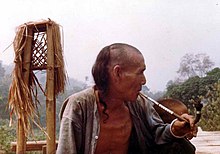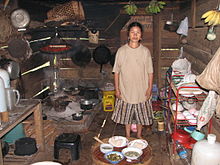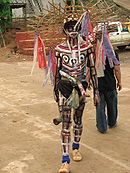Akha
The Akha (also Aka) are an ethnic group that is resident in the mountainous countries of northern Southeast Asia . They settle in the southern Chinese province of Yunnan , in the Shan State of Myanmar , as well as high-lying parts of northern Thailand , Laos and North West - Vietnam . The Akha language is one of the Lolo languages within the Tibetan-Burman language family and only knows the oral tradition without written evidence. The number of Akha is estimated to be more than 400,000. They form a relatively large minority in the countries in which they settle.
In Thailand they are recognized as one of the seven larger " mountain peoples ", in Laos as Lao Sung ("highland Lao"). In the People's Republic of China and Vietnam (17,500) they are regarded as a subgroup of the officially recognized nationality of the Hani or Hà Nhì .
Settlement area
The main settlement area today is the mountain ridges above about 1,000 m in Thailand (in the provinces of Chiang Rai , Chiang Mai , Lampang , Phrae , Tak and Kamphaeng Phet ). According to a rough estimate, around 50,000 Akha lived in a little over 300 villages in 2000. It is generally believed that they come from the Tibetan highlands, from there they migrated to Yunnan , some of which moved further to northern Burma and Laos and also reached Thailand since the mid- 19th century . Migration to Thailand can still be identified today.
Way of life
The Akha live as farmers who alternate farming with dry rice , wheat, beans, garlic and other vegetables and keep pigs and water buffalo. The Thai government is trying to turn this intensive agriculture into a more extensive form. For this purpose, aid projects are carried out.
The Akha traditionally live in bamboo huts built on wooden stakes. Their villages are mostly located on high mountain ridges in the high areas of northern Thailand, Burma, Laos and southern China. They are mostly surrounded by villages of other mountain peoples such as B. the Lahu or the Jino . Every village has a kind of “mayor” who represents the interests of the Akha vis-à-vis the Thai communities.
Akha society consists of a patrilineal kinship system that determines which group or clan provides or accepts wives. In this system, women are required to marry into clans that are classified for them as "wives-adopters" and men can only marry women who are designated as "wives-givers" for them. Each individual is therefore limited in his choice of partner, not only by the commandment of exogamy , but also by complex rules for accepting and giving from wives.
The Akha usually trade with the surrounding villages and towns. They sell their agricultural products at the local markets and buy consumer goods or clothing there.

Many of the remote villages still cultivate opium , which is especially consumed by older men and has been used for centuries for medical and religious reasons. The Thai government is trying to curb this problem with aid projects.
The basis of every meal is rice. In addition, stews, vegetable side dishes, bamboo and homemade sauces made from chilli are served. Now and then there is also chicken, pork, fish and also beetles. Whenever possible, all parts of the animal's body are consumed, including the head and bones. As usual in Asia, they eat with their hands or with chopsticks. They spoon soups from a common bowl. You can eat on a bamboo table on the floor. The homemade whiskey (jibbá) is also very popular with meals. It is also an integral part of social activities, evenings and celebrations.
The Akha are very skilled in their craft. They make many everyday objects such as baskets, containers or drinking cups out of bamboo. The village tailor sews the traditional costumes and shirts as well as hats, bags, purses or bracelets. The traditional costume of women is very colorful, they wear black hats with silver coins. The men wear black trousers with a short jacket that is loosely held together with a few buttons. The clothing is made from self-spun cotton. Their machetes, knives and fishing nets are also often their own creations.
At the entrance to many Akha villages there is a magnificent entrance and a huge swing, which is used in August during the "swing festival". The carvings at the entrances show traditional themes from everyday life, including modern ones such as cars and airplanes. These goals must not be touched or treated with disrespect.
Due to their secluded way of life, Akha villages are often a destination for trekking tourists, especially in Laos. In the meantime, projects from various international development organizations (for example GTZ ) to introduce sustainable tourism have started.
religion
The Akha are followers of a local animistic religion that includes ancestor and spirit worship. You see yourself as a link between the previous and the next generation. The honoring of the dead and the almighty spirit through offerings is thus the most important part of their religion. Each village has two gates, which are supposed to keep evil spirits out of the village. Everyone has to enter the village through these gates. At the gates there are sculptures made of wood for men and women, whose gender characteristics are clearly emphasized. An annual ritual is the renewal of the village gates.
When a village member dies, there is a five-day funeral ceremony in which the entire village takes part, and there is also a work ban. The deceased is laid out in his home and given a solemn goodbye. The main components of the ceremony are:
- - the sacrifice of animals: a water buffalo is rammed a sharpened wooden stake into the neck in order to kill it. It is then slaughtered with machetes and eaten by the villagers. A lot of whiskey is drunk with it.
- - Singing: The village elders sing around the clock for four days for the entire life of the deceased from birth to death. They often sit for hours in front of the festively decorated coffin and sing themselves in a trance. The coffin is decorated with flowers, colorful fabrics and flashing fairy lights. Some women wear their traditional costumes for the ceremony and walk through the village singing.
The day before the funeral, the spirit of the deceased must be driven out of the village. He is not allowed to stay in the village any longer, as this could have a negative impact on the lives of the other residents. He can "hide" in every house and in every person and has to be driven out by a shaman. This is brightly painted and carries a large wooden hammer and an oversized wooden penis. He runs through the streets and houses and drives the ghost out of the village with screams and blows. The funeral takes place on the fifth day after death with the family and outside the gates of the village. The graves are located in the forest and are not marked or decorated as such.
As a result of the very complex faith of the Akha, the conversion rate to Christianity achieved by missionaries practicing here since 1869 was very low. It was only 40 years later that the first Akha could be convinced, and another 27 years later the first Baptist church was established among the Akha (1936). However, since the 1980s and 1990s , Akha have increasingly joined the Christian church; However, this is less due to the work of missionaries than to the fact that, for financial or cultural reasons, they no longer have the opportunity to practice their traditional religion. There were simply no family members or elders left to explain the traditional faith.
In some cases over 60% of the residents have already converted. The Thai government has built elementary schools across the board in the Akha villages, where all classes are held in Thai . Since Buddhism is the state religion in Thailand, schoolchildren have to visit temples and practice Buddhist rites during their school days.
Problems of the people
Culture loss
One problem for the villages is the emigration of many young Akha. They turn their backs on their home villages and move to the cities. Often only the old and the children stay behind.
In many places there are already paved roads that connect the mountain villages with the Thai towns. Some villagers own scooters, and some have cars. Many villages also have sufficient power supply, satellite and cell phone reception. Many Akha already own modern electronic devices such as refrigerators, televisions, DVD players, and cell phones.
Due to the migration from the villages and the fact that there are no written documents in the Akha language, it is to be expected that one day the language and religion will completely disappear.
oppression
Many Akha in Thailand and Burma are still not citizens. Unconfirmed reports have shown repeated attacks by local police and the military recently. Akha women are said to have been raped and murdered. There are no independent confirmations for these reports.
Alcohol and other drugs
In addition to alcoholism, opium addiction threatens the tribe. Opium is now widely grown by farmers. But this drug was not always part of their culture: It was first introduced by the colonial powers, and the Akha discovered it for themselves. There are numerous projects by outsiders trying to dissuade the Akha from this drug, but this is very difficult because the people have become accustomed to using this drug over generations.
tourism
Another central problem has only arisen in the last few decades: tourism was and is still being promoted more strongly in the Akha areas. The tourists are an extremely disturbing factor in Akha life. Many Akha nowadays specialize in the tourist business. They wander through the cities in traditional costumes and sell handicrafts and jewelry, mainly in northern Thailand. There are plans for the sustainable tourism organization in the area that would allow the people time to focus on their lives again.
Alternative names
The Akha are also referred to as
- Aka
- Ahka
- Aini
- Ak'a
- Ikaw
- Akka
- Edaw
- Ekaw
- Hani
- Houni
- Ikho
- Kaw
- Kha Kho
- Kha Ko
- Kho
- Ko
- Woni
See also
Web links
- 'Hilltribes' and Forests: Minority Conflicts and Resource Conflicts in Thailand (PDF file; 177 kB)
- Meet the Akha. The role of tourism (PDF file; 127 kB)
- An examination of the Akha visual culture & symbolism considering other cultures in the same region.
- The history of the Akha Christian Community
- English-language site with information about the culture and history of the Hani (Akha)
- English-language site with information on the spread of the Akha
- Official website of the "Akha Heritage Foundation"
- Text about The Terraced Fields in Yuanyang
Individual evidence
- ↑ West (2009), article: "Akha".
- ↑ West (2009), p. 37.
- ↑ a b West (2009), p. 38
- ↑ West (2009), p. 38.
literature
- Rolf Bökemeier / Michael Friedel: Lost people, encounter with peoples who will no longer exist tomorrow . Geo published by Gruner + Jahr AG & CO., Hamburg 1984.
- Barbara A. West: Encyclopedia of the Peoples of Asia and Oceania . Facts on File, New York 2009, ISBN 0-8160-7109-8 .







